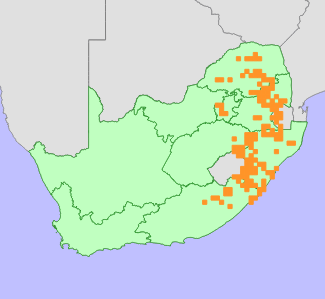| Scientific Name | Protea roupelliae Meisn. subsp. roupelliae | Higher Classification | Dicotyledons | Family | PROTEACEAE | Synonyms | Protea incana Hort. ex Meisn. | Common Names | Drakensberg Protea (e), Isiqalaba (z), Isiqalaba (x), Segwapi (ns), Silver Sugarbush (e), Silver-leaved Protea (e), Silwerblaar-suikerbos (a), Silwer-suikerbos (a), Suikerbos (a), Transvaal Silver-leaf (e), Tshididiri (v), Uqhambathi (z) |
National Status | Status and Criteria | Least Concern | Assessment Date | 2019/06/12 | Assessor(s) | A.G. Rebelo, H. Mtshali & L. von Staden | Justification | Protea roupelliae subsp. roupelliae has a wide distribution range with an extent of occurrence (EOO) of 359 719-361 971 km². It is very common within its range. The subspecies is sometimes harvested for firewood but this is not a severe threat. Therefore it is listed as Least Concern. |
Distribution | Endemism | Not endemic to South Africa | Provincial distribution | Eastern Cape, Free State, Gauteng, KwaZulu-Natal, Limpopo, Mpumalanga, North West | Range | This subspecies has a widespread distribution range across the eastern and northern provinces of South Africa, extending to Eswatini (Swaziland) and Lesotho. |
Habitat and Ecology | Major system | Terrestrial | Major habitats | Rand Highveld Grassland, Woodbush Granite Grassland, Northern Escarpment Afromontane Fynbos, Northern Escarpment Quartzite Sourveld, Northern Escarpment Dolomite Grassland, Leolo Summit Sourveld, Sekhukhune Montane Grassland, Barberton Montane Grassland, KaNgwane Montane Grassland, Paulpietersburg Moist Grassland, Wakkerstroom Montane Grassland, KwaZulu-Natal Coastal Belt Grassland, Eastern Highveld Grassland, Soutpansberg Summit Sourveld, Egoli Granite Grassland, Carletonville Dolomite Grassland, Lesotho Highland Basalt Grassland, uKhahlamba Basalt Grassland, Drakensberg-Amathole Afromontane Fynbos, Northern Drakensberg Highland Grassland, Southern Drakensberg Highland Grassland, Scarp Forest, Northern Afrotemperate Forest, KwaZulu-Natal Coastal Belt Thornveld, Pondoland-Ugu Sandstone Coastal Sourveld, Amersfoort Highveld Clay Grassland, Dry Coast Hinterland Grassland, Northern Zululand Sourveld, Gold Reef Mountain Bushveld, Mamabolo Mountain Bushveld, Soutpansberg Mountain Bushveld, Waterberg Mountain Bushveld, Andesite Mountain Bushveld, Gauteng Shale Mountain Bushveld, Midlands Mistbelt Grassland, Mooi River Highland Grassland, Northern KwaZulu-Natal Moist Grassland, Low Escarpment Moist Grassland, Wolkberg Dolomite Grassland, Ithala Quartzite Sourveld, Strydpoort Summit Sourveld, Mthatha Moist Grassland, East Griqualand Grassland, Southern KwaZulu-Natal Moist Grassland, Drakensberg Foothill Moist Grassland, Basotho Montane Shrubland, Eastern Free State Sandy Grassland, Long Tom Pass Montane Grassland, Steenkampsberg Montane Grassland, Eastern Free State Clay Grassland, Waterberg-Magaliesberg Summit Sourveld, Crocodile Gorge Mountain Bushveld, Moist Coast Hinterland Grassland | Description | It occurs in variable habitat, found in many vegetation and soil types, 0-2400 m. It is a small, upright tree. |
Threats | | Protea roupelliae subsp. roupelliae is over harvested for firewood and some subpopulations are threatened by too frequent fires, however the impact is very low. There has also been some habitat loss to afforestation and urban and agricultural development. |
Population | It is reported to be dominant in open protea woodland across much of its range. It was apparently present in Lesotho in the past, but no details of extant localities are available. Presumably these occurred in areas similar in distribution and habitat to P. caffra in the northern parts. No known subpopulations occur there today and none were found during the Protea Atlas Project surveys that ran from 1992 to 2002.
| Population trend | Stable |
Notes | | Protea roupelliae subsp. roupelliae is similar to P. roupelliae subsp. hamiltonii, but these two subspecies differ primarily in their growth. The latter is a low, sprawling shrublet forming mats up to 0.3 m tall and 1 m across. P. roupelliae subsp. roupelliae forming a small upright tree of about 4-8 m high. |
Assessment History |
Taxon assessed |
Status and Criteria |
Citation/Red List version | | Protea roupelliae Meisn. subsp. roupelliae | Least Concern | Raimondo et al. (2009) | | Protea roupelliae Meisn. subsp. roupelliae | Not Threatened | Hilton-Taylor (1996) | |
Bibliography | Boon, R. 2010. Pooley's Trees of eastern South Africa. Flora and Fauna Publications Trust, Durban.
Hilton-Taylor, C. 1996. Red data list of southern African plants. Strelitzia 4. South African National Botanical Institute, Pretoria.
Raimondo, D., von Staden, L., Foden, W., Victor, J.E., Helme, N.A., Turner, R.C., Kamundi, D.A. and Manyama, P.A. 2009. Red List of South African Plants. Strelitzia 25. South African National Biodiversity Institute, Pretoria.
Rebelo, T. 2001. Sasol Proteas: A field guide to the proteas of southern Africa. (2nd ed.). Fernwood Press, Vlaeberg, Cape Town.
|
Citation | | Rebelo, A.G., Mtshali, H. & von Staden, L. 2019. Protea roupelliae Meisn. subsp. roupelliae. National Assessment: Red List of South African Plants version 2024.1. Accessed on 2025/11/24 |
 Comment on this assessment Comment on this assessment
|
 © D. Turner  © L. von Staden
Search for images of Protea roupelliae subsp. roupelliae on iNaturalist
|
 Comment on this assessment
Comment on this assessment

